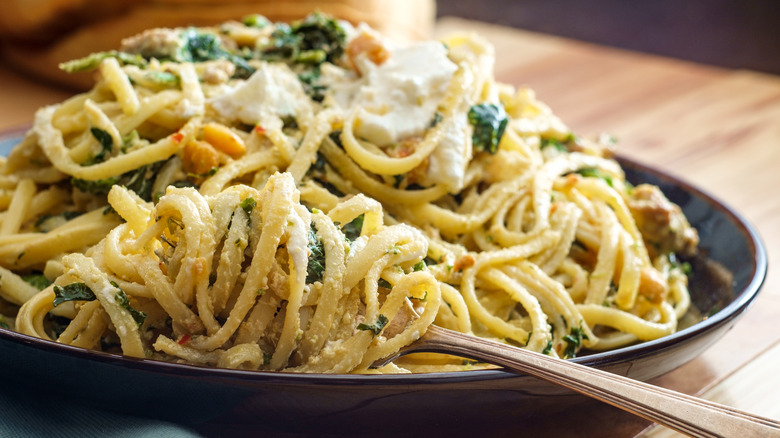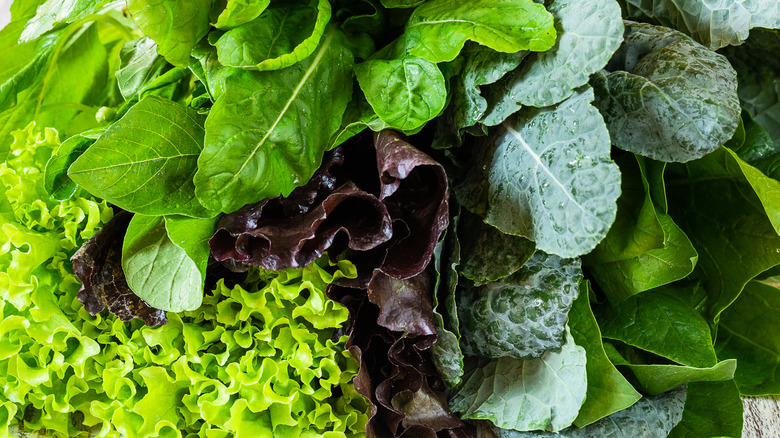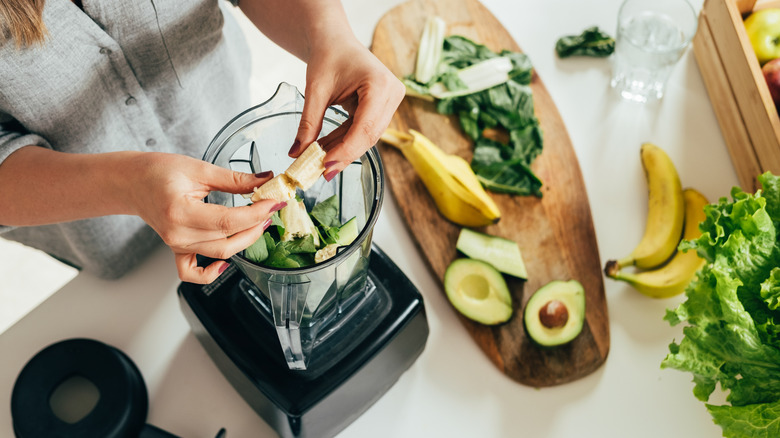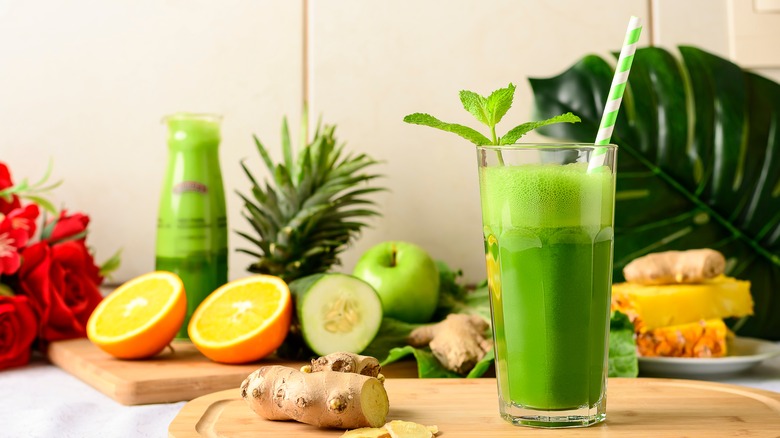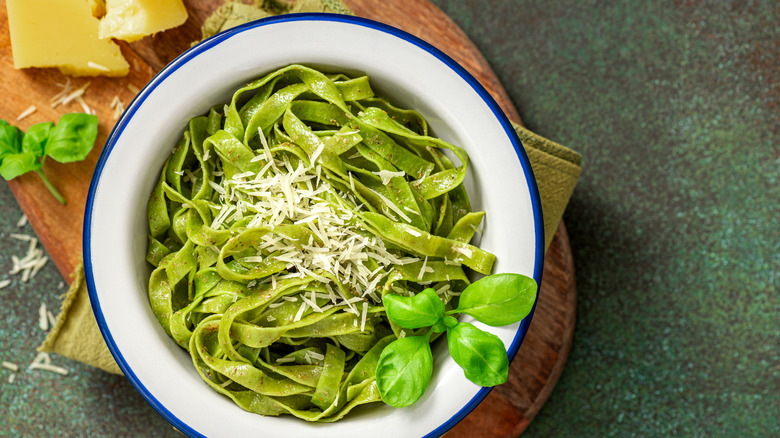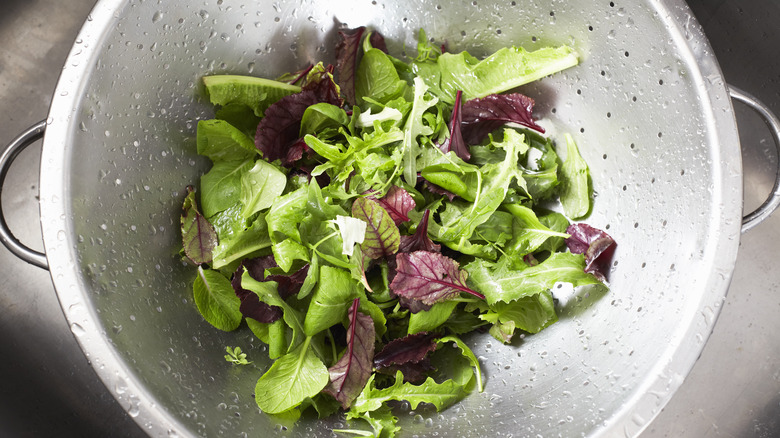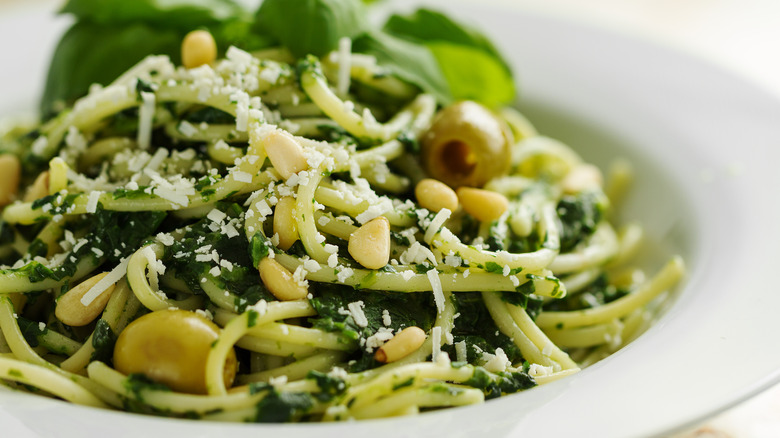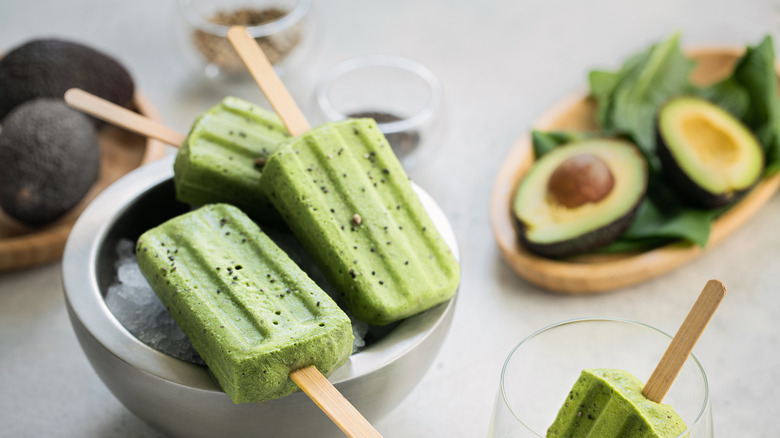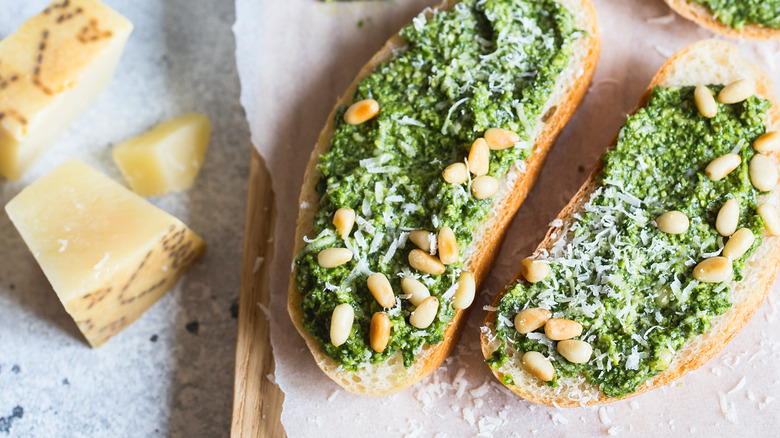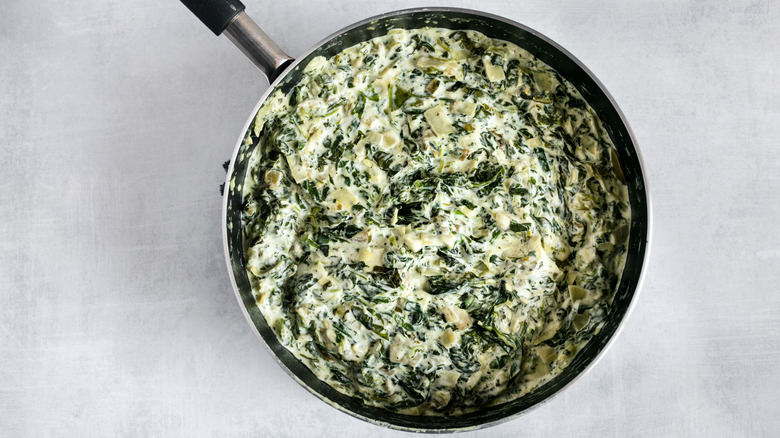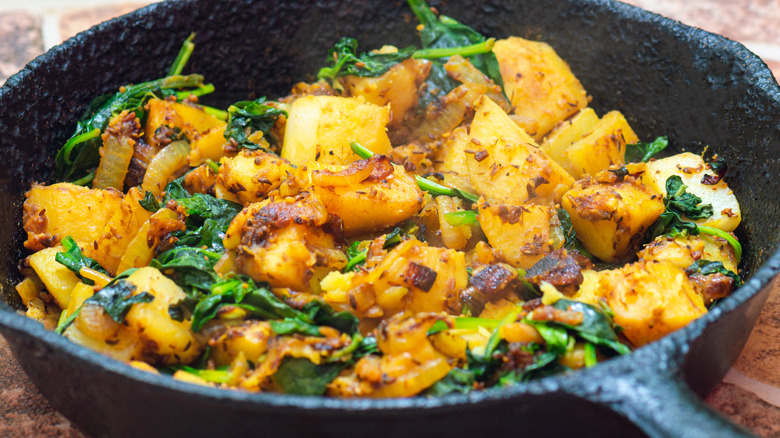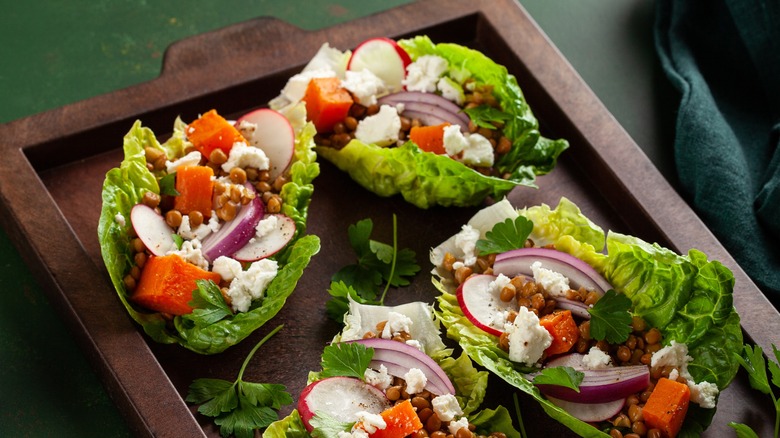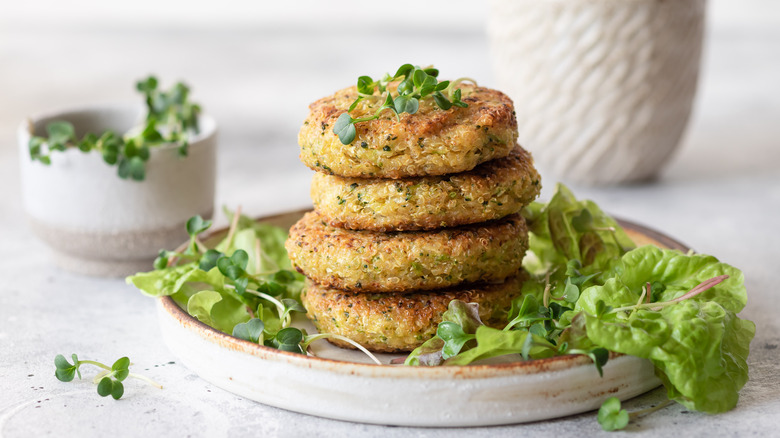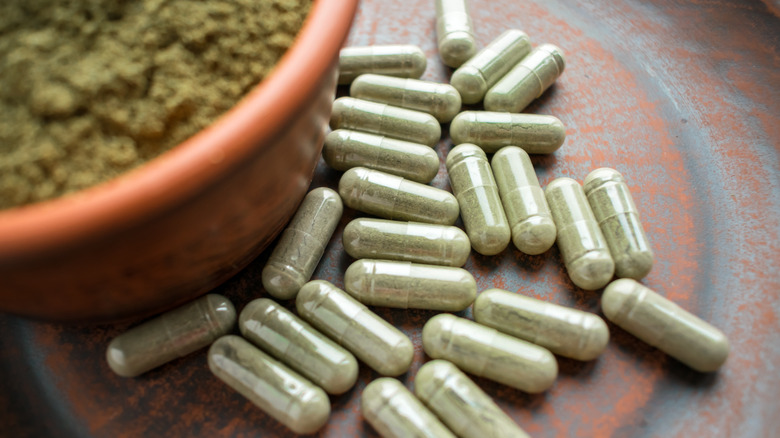The Ultimate Guide To Sneaking More Leafy Greens Into Your Diet
Salad: You either love it, or you hate it. For those of us who have trouble channeling our inner rabbit, getting the recommended daily allowance of leafy greens may be difficult. But the truth is that they are incredibly nutritious and an important part of a balanced diet. Per NutritionFacts.org, they are packed with nutrients like calcium, iron, folate, antioxidants, and potassium, which help to reduce inflammation. The veggies may also help build up the immune system, reduce free radical damage, lower the risk of glaucoma, and even prevent signs of premature aging. According to the USDA, just two to three servings of these vegetables per week have been linked to a reduced risk of stomach, breast, and skin cancer.
The USDA also found that most Americans are under-consuming the powerhouse superfood. So, it's time to take matters into your own hands and sneak in those veggies where you can. Even just one additional serving per day can make all the difference. If it's difficult to get your little picky eater on board (or heck, even yourself), there are ways that you can get your daily dose without having to dive headfirst into a bowl of raw veggies. That's why we've provided the ultimate guide to adding more leafy greens to your diet. However, not all of them are created equal, so it's important to understand what's available, which will give you the most bang for your buck, and how to best prepare them.
Choose from a variety of greens
It seems kale has been all the rage for the last decade, but not everyone has taken a liking to the tough curly leaves. If you're not a super fan of trendy greens, do not fear because there are endless options to choose from.
Lettuce is delicate, light in color, papery, and often mild in flavor. Iceberg, romaine, red and green leaf, bibb, and mesclun fall into this category and are, for the most part, enjoyed raw. These greens are perfect for salads, and most of them are quite unappealing when heated (although we like the occasional grilled romaine Ceasar salad). Consume them as a salad, a topping for tacos, or in a sandwich. Freshly dress these greens, and keep them refrigerated.
Dark leafy greens, like kale, arugula, spinach, mustard greens, collard greens, Swiss chard, and bok choy, are a little more robust. Most of them do quite well when heated and are often added to stir-fries, blended into smoothies, or even roasted. Some taste even better bruised, which is why you should always massage kale salad. Although all greens pack quite a punch when it comes to nutrient density, dark leafy greens take the lead — especially as veggies you can easily sneak into your diet.
Blend them into green smoothies
Since we were young, our mothers have been blending vegetables into our smoothies without our knowledge, and we are glad they did! It's the perfect way to hide them because, let's face it, we're not always in the mood to scarf down some kale come breakfast time. Start your day off right with a green smoothie. Kale and spinach are popular ingredients because of their high nutrient content and mild flavor. If you're worried about the color, try using colorful additions like blueberries, cherries, or beets.
If the idea of a bright green smoothie does not turn you off, lean into it and load up on avocado for a creamy texture, banana for added sweetness (seriously, frozen banana tastes like ice cream), and kiwi. If you don't know where to start, check out a few healthy vegetable-fruit smoothie recipes, or add just a handful of raw spinach to your favorite one. When in doubt, blend a frozen banana with plant-based milk, add a few tablespoons of peanut butter, and a large handful of leafy greens. There you have it, a super indulgent peanut butter shake, bright green and ready to drink.
Juice them
If you can't stand to eat your greens, plug your nose and drink them instead. Juicing is a great way to concentrate nutrients from fruits and vegetables and knock it all back in one quick gulp. Although the fiber is removed during the process, the vitamins and minerals remain intact, so if you have your juicer ready, it's time to experiment with green juices.
If you're trying to sneak more leafy greens into your diet, it may be safe to assume that you're not a huge fan of the flavor, so blending up a batch of spinach juice isn't going to do the trick. Instead, mask the flavors of the veggies with dark, sweet fruits.
Pineapple, cherries, citrus, and pomegranate mask the flavor nicely, although your juice might look rather unappealing in color. If you really don't mind the taste or are planning to chug it down quickly, then go all in and add celery, beets, carrots, cucumber, and other healthy vegetables. Try a crisp and gingery green juice recipe for added anti-inflammatory benefits. This could just be the start to your day that you wish you had discovered earlier.
Hide them in pasta dough
If you have the time and energy to make your own pasta, you're in luck. We all know that the flavor of fresh pasta goes unmatched, but we can also appreciate that it's quite a process to make. For those who enjoy going elbows-deep in flour and eggs, it's time to take advantage of the situation and start making green pasta.
Simply blanch your spinach or green of choice and rinse under cold water to stop the cooking process. Then either blend it with one of your eggs or chop it into small pieces for more of a speckled appearance. Incorporate the veggie into the flour like you would an egg, and get to kneading. Adding more flour to balance out the liquid-to-solid ratio may be necessary, so keep an eye on how tough your dough is.
Try this method with any shape of pasta or gnocchi. Better yet, mix blanched spinach with ricotta and stuff it into homemade ravioli. Even though it will be bright green, we can assure you that your handmade pasta will be the envy of any box of Barilla's in the grocery store.
Keep them fresh for salads
For those who have to work up the courage to finish your salad in the first place, we want to be sure you're giving yourself the best chance possible for success. Keep in mind that old and slimy lettuce tastes bad to everyone; no one wants to serve wilted greens if they can help it. That said, to keep things crisp, keep the delicate veggies cold at all times. This might mean you need to store it in the refrigerator until the very last minute.
In addition, avoid chopping lettuce with a knife. Instead, delicately tear the pieces apart with your hands; this will prevent bruising and result in an overall more aesthetically pleasing salad. Store leafy greens in the crisper, and add a dry paper towel to absorb moisture to ensure longevity. If your veggies are starting to look questionable, rinse them in ice water before spinning them dry; this can help perk them up and keep them looking and tasting fresh.
If salad still isn't doing it for you, try experimenting with different dressings, which should help mask the flavor of the greens considerably. Just note that delicate greens should not be dressed more than a few minutes before serving. Lettuce will quickly wilt and become mushy. On the other hand, kale loves to marinate in a dressing.
Mince them for sauces or dressings
Sauce is the perfect hiding place for dark leafy greens. For pasta fans, sneaking these veggies into your diet has never been easier. Simply mince spinach up and cook it directly in the marinara. If you're making sauce from scratch, add the greens at the last minute, so they don't overcook. This will help keep the flavor mild and the texture pleasing.
For a white sauce, consider blending the greens right into the mix or sautéing chopped kale with your favorite pasta toppings, like sliced mushrooms and toasted walnuts. Add a splash of tamari or sea salt, and throw your ingredients on top. Not only will your pasta look absolutely beautiful, but it will vary in texture, which can be quite pleasing.
Take another approach and add a handful of raw arugula to your pasta or pasta salad bowl. It will remain crunchy if not overheated, as this variety holds up well and will give your dish a kick. The contrast of creamy hot pasta to cool, crunchy arugula has a complex mouthfeel that can elevate the recipe to a whole new level. The less you like leafy greens, the finer you should chop them. Smaller pieces often go unnoticed or unrecognized.
Cool off with green popsicles
Who doesn't love to cool off with an ice-cold popsicle in the summertime? Kids and adults alike can't resist the frozen treat, so it's the perfect opportunity to sneak some leafy greens into the mix. This should be a breeze for those who are used to making healthy homemade popsicles in the summer. Simply pour juice or smoothies into an ice pop mold, and let your freezer do the rest.
If you plan to hide the leafy greens altogether, add juiced or blended spinach or kale to naturally green pops, like those made with kiwi, limeade, or honeydew melon. Who has to know? Dark smoothies and juices will also help to mask any green color, so spring for deep red fruits and vegetables.
For those new to the magic of homemade popsicles, consider buying a popsicle mold and live by one rule: If you would drink it, then you should popsicle-ize it.
Make leafy green pesto
Basil isn't the only green you should use to make pesto. In fact, if you've stuck exclusively to basil pesto your who life, you might be missing out on a fantastic opportunity to sneak more leafy veggies into your diet. Expand your recipe into a green, nut-based garlic sauce. Choose a nut and a dark leafy vegetable, micro-green, or fresh herb (basil, cilantro, and parsley work well). Add some garlic, pepper, salt, and olive oil, and you have a pesto! You can also mix in lemon juice, nutritional yeast, and parmesan for additional flavor or stick to the classic formula.
Scapes, kale, herbs, carrot tops, spinach, and arugula are all incredible options for making a variation of your favorite garlicky sauce. The beauty of pesto is that it isn't exclusively for pasta. Yes, it tastes amazing when mixed into noodles, but it also makes for a delicious sandwich spread, toast topping, grain bowl sauce, charcuterie dip for cheese and crackers, and topping for roasted vegetables or meat.
Add greens to dips
Who doesn't love dunking their chip deep into a vat of salty, creamy, delicious dip? It doesn't have to be Super Bowl Sunday for you to make it for the family. Use it as a method to sneak more leafy greens into everyone's diet — because nobody can resist appetizers. Blend the veggies right into hummus or a white bean dip. Yes, it will turn bright green, but that's just part of the fun aesthetic, and let's face it, everyone will feel a little healthier just by looking at it.
Not quite ready to stray from a classic? Try making spinach and artichoke dip. This creamy, dreamy recipe is the perfect place for spinach to hide. Even though it's right there in the title, leafy green lovers and haters alike can't resist it. It's a foolproof way to get the family on board with your new veggie kick. Try making your own homemade creamy spinach dip recipe, or steam some spinach to add to a store-bought version to give it an extra nutrient boost.
Whip up a tasty side dish
These veggies have always seemed to find their way to side dish status, so why not lean into it? Whether you're making maple-glazed carrots, scalloped potatoes, or peas, there's always room for a handful of greens. Swiss chard, bok choy, kale, spinach, or mustard greens can be chopped, steamed, and mixed into just about any side dish. Make a bed of these veggies for your mashed potatoes, or crumble kale chips over mac and cheese. (In fact, kale chips can be enjoyed crumbled over pretty much any savory side dish and still taste delicious.)
Get creative and mix chopped leafy greens into chilled side dishes like pasta or potato salad. You can add raw spinach, basil, and mint to a fruit salad or layer it into a Caprese salad. If you're choosing to cook the greens instead, make sure you do it properly; there's nothing worse than soggy spinach or burnt bok choy.
Replace buns and taco shells
Gluten-free veterans and keto folks know that a lettuce bun is the oldest trick in the book, but it may come as a new life hack to those who haven't had the pleasure.
Try enjoying your cheeseburger with an iceberg lettuce bun; slice two sides off the rounded part of an iceberg head, about the size of the buns. They have a very pleasing crunch and don't alter the flavor much. If you really want to maximize the nutritional value, blend dark leafy greens into your homemade bean burger or veggie burgers and load them up with kale, Swiss chard, and spinach.
Romaine lettuce leaves can be made into delicious taco shells, and don't forget to mince up some dark leafy greens to add to your meat or beans. Use massive collard greens to make a tortilla shell for burritos or wraps; simply blanch a few large leaves, cut the stem out, later them together, and stack them with your desired fillings before rolling it all up.
Sneak greens into stir-fries
No matter which direction you go, there is always room for dark leafy greens in a stir-fry. Kale will complement your sweet potato hash deliciously, while bok choy will bring an Asia-inspired recipe to the next level. Chopped collard or mustard greens work well in a southern barbecue dish, while spinach blends perfectly into a tofu scramble.
Cooked leafy greens will absorb and retain sauce beautifully, giving your meal a power-packed blast of flavor. Just remember to chop them into small pieces if you don't love the idea of biting into a big mouthful of them; this will help them distribute evenly throughout the dish.
Also, don't forget to add these veggies to your wok or pan at the last minute. Don't heat lettuce, although grilled romaine and roasted endive varieties can be quite delicious. Delicate greens like spinach can be tossed in even after the heat is off, as the dish will continue cooking as the pan remains hot. More robust greens like collard greens may need to simmer in a hot pan to cook thoroughly, but they should still be added after your crunchier vegetables.
Use leafy greens as a garnish
Although meat and potatoes can taste delicious, they can also look quite dull. A plate filled with brown, tan, and white foods can feel like a cafeteria lunch, and that's certainly not the vibe you want when serving guests or even yourself, for that matter. Even a side dish of colorful veggies to add a little pizzazz can go a long way. If you're looking for a quick fix, try adding some greenery to the mix. Consider topping your pasta with raw basil and arugula. Serve your baked potato or white fish over a pile of steamed kale. Chop spinach and sprinkle it over your lasagna. Add a sprig or two of parsley to that T-bone steak. Even chopped mint can add an extra splash to your colorful fruit salad.
While a sprig or handful here or there may seem unmonumental, keep in mind that throughout the week, it adds up. And heck, it's more than you were getting before! This is an especially good way to segway picky eaters into consuming more leafy greens — one baby step at a time.
Swallow them in capsule form
So, you've tried it all: smoothies, garnishes, hiding leafy greens in your sauces. But you can't quite seem to get over that earthy flavor and bright green hue. It's hard to cut out a whole food group when you know it's so essential for human health, yet you can't be expected to force down a super green smoothie every morning if you just plain hate it. The good news is that the more you eat a particular food, the more your tastebuds will grow accustomed to the flavor. One day, you may even enjoy it — or better yet, crave it. While this takes time and quite a heavy dose of motivation, workarounds can help you meet your nutritional requirements without involving your tastebuds.
Companies have now created leafy greens in powdered and capsule form. That's right; you can now swallow (some) greens. Do a quick Google search to find the brand that best aligns with your needs. If you'd prefer to do things your own way, purchase super greens powder, typically meant for smoothies, and add it to capsules yourself. You can even make your own homemade powder by dehydrating and blending greens. While this may not be an exact substitute for eating greens, it can help you on your way to incorporating them into your diet.
It looks like you might be fresh out of excuses for avoiding those green leaves that have given you so much trouble throughout the years!
